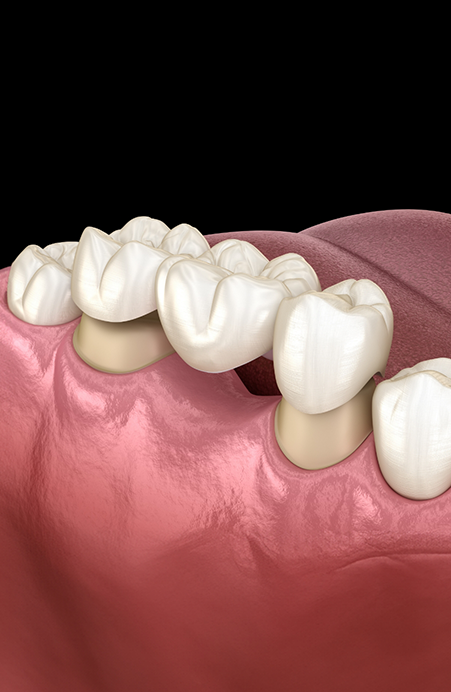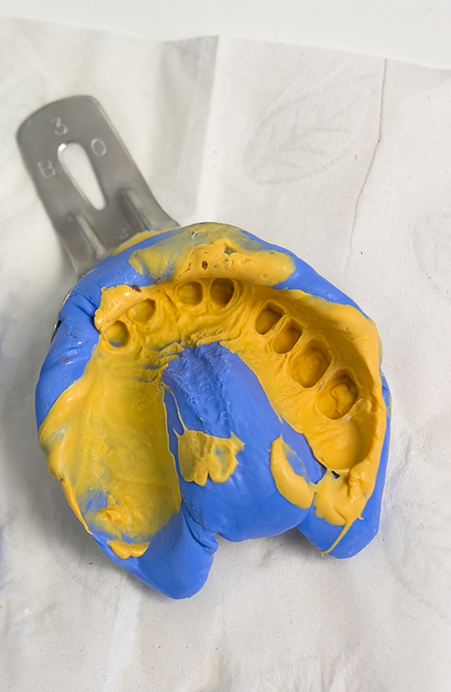Dental Bridges Greensboro
Literally “Bridge” the Gap in Your Smile

If injury or decay has caused you to lose a tooth (or even multiple teeth), you don’t have to live with your incomplete grin forever! You may be a perfect candidate for a fixed dental bridge in Greensboro. This restorative treatment can provide you with a sturdy, long-lasting way to fill in that gap and help you enjoy a comfortable, confident smile.
Why Choose Dr. David M. Fisher, Jr. for Fixed Dental Bridges?
- Experienced Dentist and Team Members
- Welcoming Office Atmosphere
- Close Attention to Detail Creates Quality Restorations
What Is a Fixed Bridge?

Dental bridges are composed of multiple restorations; one or more prosthetic teeth (called pontics) are held between two dental crowns, which are permanently attached to the abutment teeth adjacent to the space. There are actually a few different styles of dental bridges; we’ll recommend one based on how strong and healthy your remaining teeth are and where the gap is located in your mouth. The average dental bridge will last about 8 to 10 years before it needs to be replaced. You can take care of it through regular brushing and flossing (though you should take care not to neglect the gums underneath the pontics).
Some patients don’t have healthy abutment teeth for the bridge to rest on. In those cases, they might be supported by a pair of dental implant posts instead. We might also recommend a removable partial denture if you happen to be missing many teeth in a row.
What Benefits Does a Dental Bridge Offer?

A fixed dental bridge from your dentist in Greensboro offers many outstanding benefits:
- A bridge can complement your smile’s natural beauty. Porcelain, one of the materials commonly used to create pontics and crowns, is very close in color to tooth enamel. It even reflects light in a manner that is similar to that of natural teeth, so no one may be able to tell that you’ve had some work done.
- Bridges are quite strong. You’ll be able to enjoy almost all of your favorite foods without worrying that you’ll damage your restoration.
- It is easy to care for a dental bridge. The only adjustment that you’ll have to make to your oral hygiene routine requires you to floss underneath the pontic to remove any plaque and food particles that might get caught between it and your gums.
- A bridge can prevent your natural teeth from drifting out of place, thereby preventing malocclusion (a bad bite).
What Is the Process for Placing a Dental Bridge?

The process for placing a dental bridge takes at least two appointments. At your first appointment, we prepare your abutment teeth by removing a portion of their enamel. This ensures that the crowns will fit comfortably over them. Then, we take impressions of your teeth, which a laboratory will use to create your custom bridge. We give you a temporary bridge to wear until your permanent one is ready.
At your second appointment, we remove the temporary bridge and place your new one in your mouth. We might have to make a few minor adjustments to the way it fits. Once your bridge is permanently in place, you can go off and enjoy your newly restored smile!
If you have questions about crown and bridgework or any other dental prosthesis, call our Greensboro dental office. We will be happy to discuss the options and schedule your evaluation.
Dental Bridge FAQs
What foods should I avoid with dental bridges?
Just like with traditional dental crowns, we do not recommend eating large amounts of caramel, chewing gum, or other very sticky foods, especially within the earliest stages of placement. This is because the bridge still needs time to complete a bond with adjacent teeth. While you can eat most foods confidently with a dental bridge, a few exceptions do pose a greater risk on average. Additionally, very sticky foods can get caught beneath or underneath a dental bridge, making it hard to clean.
Will my dental bridge give me bad breath?
If a bridge does not fit properly, food debris can more easily get stuck underneath it. This area is generally more difficult to clean, allowing food to rot and develop a poor smell inside your mouth. That’s why our office always takes the time to confirm your bridge fits flush against your gum line and remains that way going forward. With a few at-home oral care tips, removing loose food debris and keeping your breath smelling fresh is a relatively straightforward process.
How do I effectively clean my dental bridge?
While a toothbrush and fluoridated toothpaste will keep your teeth and gums clean, it’s understandable if you need time to get used to cleaning a bridge fully and completely. To do so, we would recommend purchasing an affordable interdental brush or floss threader to adequately clean underneath your restoration. You may also want to consider a water pick if this process feels too difficult for you to complete. Dr. Fisher is happy to walk you through what he’s learned over the years to be the best and easiest way to keep a dental bridge clean and free of plaque.
What’s the best way to make dental bridges affordable?
At the end of the day, your oral health is a top priority. Of course, we understand that not everyone can easily afford complex restorations like dental bridges, whether they are retained with dental implants or not. While we do accept dental insurance, those who do not currently have a plan may want to explore other third-party options like CareCredit. This option is designed to help patients cover the costs of their care over longer periods of time, making even expensive tooth replacements accessible to more patients. And, depending on the plan, you can potentially avoid paying any interest on your installments.

